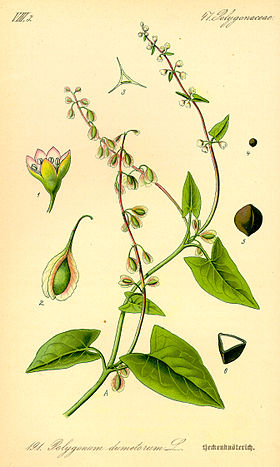pms
nòm ant ël fil


 1885 illustration[1] Clasificare științifică
1885 illustration[1] Clasificare științifică Bilderdykia Dumortier
Modifică textFallopia este un gen care cuprinde circa 12–15 specii de flori din familia umbra pământului,[3] often included in a wider treatment of the related genus Polygonum in the past. The genus is native to temperate and subtropical regions of the Northern Hemisphere. The genus includes herbaceous perennial plants, herbaceous vines, and woody vines.[2][4][5][6]
Several species are serious invasive weeds, notably Japanese knotweed in Europe and North America.[7][8][9][10]
The genus is named after Italian botanist Gabriello Fallopio, or Fallopius, who was the superintendent of the botanical garden at Padua. He was also an acclaimed anatomist, being considered a founder of modern anatomy along with Vesalius and Eustachius.
Fallopia species are used as food plants by the larvae of some Lepidoptera species including Coleophora therinella (recorded on F. convolvulus).
Crosses between Japanese knotweed and giant knotweed have occurred where the two species grow in close proximity. The hybrid, Fallopia × bohemica (syn. Polygonum × bohemicum) is known as Bohemian knotweed.
Fallopia × conollyana (F. baldschuanica × F. japonica) is called railway-yard knotweed.
Recently, Japanese knotweed (Fallopia japonica, syn. Polygonum japonicum, Polygonum cuspidatum, Reynoutria japonica) and others have been used to exploit their high concentrations of trans-resveratrol in the plants' stalks. Previously associated with and identified mainly in the skins of red grapes, resveratrol is currently under study in a number of research projects investigating its possible antiaging properties.
Fallopia este un gen care cuprinde circa 12–15 specii de flori din familia umbra pământului, often included in a wider treatment of the related genus Polygonum in the past. The genus is native to temperate and subtropical regions of the Northern Hemisphere. The genus includes herbaceous perennial plants, herbaceous vines, and woody vines.
Several species are serious invasive weeds, notably Japanese knotweed in Europe and North America.
The genus is named after Italian botanist Gabriello Fallopio, or Fallopius, who was the superintendent of the botanical garden at Padua. He was also an acclaimed anatomist, being considered a founder of modern anatomy along with Vesalius and Eustachius.
Fallopia species are used as food plants by the larvae of some Lepidoptera species including Coleophora therinella (recorded on F. convolvulus).